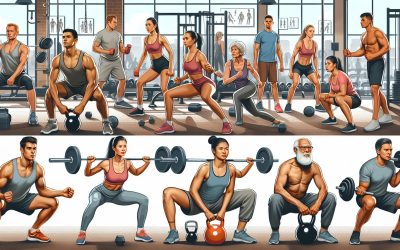Understanding the anatomy and function of your biceps is essential for getting the most out of your workouts. The biceps brachii, commonly known as the biceps, is a two-headed muscle located on the upper arm between the shoulder and the elbow. This muscle is responsible for various movements, including the flexion of the elbow and the supination of the forearm, which means turning the palm up or forward. This dual functionality makes the biceps crucial not only for lifting but also for the rotational movements of the arm.
Furthermore, the biceps muscle plays a significant role in the aesthetics of the upper body, contributing to the rounded appearance of the upper arm when developed. Thus, when considering what to workout with biceps, it’s vital to include exercises that target both heads of the muscle for balanced growth and strength. For instance, hammer curls emphasize the brachialis, a muscle that lies beneath the biceps, enhancing the overall thickness of the arm.
By incorporating a variety of exercises into your regimen, you can ensure that all aspects of the biceps muscle are engaged. This approach leads to not only more functional strength but also a more defined and aesthetically pleasing appearance. And remember, proper form and technique are just as important as the exercises themselves to prevent injury and maximize gains.
Ready to kickstart your wellness journey? Sign up for our content at Health And Healing AI to receive exclusive tips and updates. Take the first step towards a healthier, happier you! Join Our Community Today!
Essential Bicep Exercises for Strength and Mass
To build both strength and mass in the biceps, it’s important to focus on exercises that provide enough stimulus for muscle growth. One fundamental exercise is the standing barbell curl, which targets the entire biceps muscle group and allows for heavy lifting, stimulating hypertrophy. Another essential movement is the dumbbell curl, performed either alternating or simultaneously, which helps in developing unilateral strength and balances out any asymmetries.
In addition to these, incorporating concentration curls can be particularly effective for peak contraction, as they isolate the biceps and prevent other muscles from assisting in the lift. For those looking to enhance the ‘peak’ of their biceps, incline dumbbell curls are excellent as they stretch the long head of the biceps, working it through a full range of motion.
To optimize bicep development, it is also advisable to include exercises that target the brachialis and brachioradialis, such as hammer curls and reverse curls. These movements complement the bicep curls and contribute to the overall size of the arms. Lastly, incorporating cable curls can offer consistent tension throughout the exercise, which is beneficial for muscle growth.
When planning what to workout with biceps, variety and progressive overload are key. Gradually increasing the weight and mixing these exercises into your routine will lead to significant improvements in both strength and mass over time. It’s crucial to pay attention to form and maintain control throughout each movement to prevent injury and ensure the biceps are fully engaged during each exercise.
Incorporating Compound Movements with Bicep Training

While isolation exercises are crucial for bicep development, incorporating compound movements into your training regimen can significantly enhance overall arm strength and size. Compound exercises engage multiple muscle groups and joints, leading to greater hormonal responses and potential for muscle growth.
One of the most effective compound exercises for biceps is the pull-up. When performed with a supinated grip (palms facing you), pull-ups not only work the back muscles but also place a considerable amount of stress on the biceps, encouraging strength and hypertrophy. Similarly, chin-ups are a close relative to pull-ups with a greater emphasis on the biceps, making them another excellent choice for compound bicep training.
Another key compound movement is the barbell row. While primarily targeting the upper back, maintaining a proper form during the exercise also involves the biceps which act as secondary muscles, aiding in the pulling motion. Additionally, the deadlift, one of the most comprehensive compound exercises, indirectly works the biceps through isometric tension as they help in gripping and holding the bar.
It’s important to remember that when integrating compound movements with bicep-focused training, balance is essential. These exercises should complement your bicep workouts, not overshadow them. By combining compound and isolation exercises, you’re ensuring a well-rounded approach to arm development that can yield impressive results in both strength and aesthetic.
Understanding what to workout with biceps can make a significant difference in your training outcomes. With the right mix of compound and isolation exercises, you can achieve a balanced and powerful upper body physique.
Maximizing Your Bicep Growth with Proper Technique

Maximizing bicep growth requires more than just lifting weights; proper technique is paramount. To ensure you are on the path to achieving the best possible results, focus on the quality of each movement rather than the quantity of weight used. A key aspect of proper technique involves mind-muscle connection. This practice entails concentrating on the bicep muscle during each curl to enhance muscle activation and growth.
Start by selecting a weight that allows you to perform exercises with control and full range of motion. During a bicep curl, for instance, ensure that your elbows are close to your torso and that you are not using momentum to lift the weights. The movement should be slow and deliberate, with a squeeze at the top of the contraction and a controlled descent to fully engage the muscle fibers.
Another aspect of technique is the wrist position. Keeping your wrists straight and firm throughout the exercise can prevent strain and maintain the focus on the biceps. Additionally, varying your grip width and style – such as using a hammer grip – can target different parts of the biceps and contribute to overall arm development.
Lastly, breathing correctly is often overlooked but is essential for maximizing bicep growth. Inhale as you lower the weight and exhale during the muscle contraction. This not only helps maintain rhythm but also ensures adequate oxygen supply to the muscles, which is crucial for sustained muscle performance and growth.
By paying close attention to these technical elements, you will be able to work out with biceps more effectively and see a noticeable difference in muscle growth and definition. Remember, it’s not just about lifting heavy; it’s about lifting right.
Balancing Bicep Workouts with Overall Fitness Goals

When focusing on what to workout with biceps, it is crucial to balance these exercises with your overall fitness goals. Bicep workouts should be part of a comprehensive training routine that promotes muscle harmony and prevents imbalances. To achieve this, it’s essential to incorporate exercises that target the opposing muscle group, the triceps, as well as compound movements that engage multiple muscle groups.
For a harmonious upper body development, integrate push-pull exercises into your regimen. This ensures that you’re not overworking the biceps and neglecting other important muscles that contribute to arm strength and functionality. Exercises such as push-ups, bench presses, and rows work a range of muscles and can enhance overall upper body aesthetics and performance.
Moreover, it’s important to consider how bicep workouts fit into your total body fitness plan. If your goal is to increase muscle mass, higher volume and intensity for bicep exercises can be beneficial. However, if you’re aiming for a lean physique or weight loss, your bicep workouts should be complemented with cardiovascular exercise and a caloric deficit in your diet.
Lastly, don’t forget the importance of rest and recovery. Muscles need time to repair and grow, and the biceps are no exception. Ensure you’re allowing enough time between bicep workouts for recovery, and consider incorporating stretching and foam rolling to aid in muscle recovery and flexibility.
In conclusion, balancing your bicep workouts with your overall fitness goals means considering a variety of exercises, paying attention to the rest of your body, and aligning your routines with your desired outcomes. By doing so, you’ll not only achieve better bicep development but also enhance your overall health and fitness levels.
Nutrition and Recovery Tips for Bicep Development

Ready to kickstart your wellness journey? Nutrition and recovery play pivotal roles in achieving well-defined biceps and should not be overlooked. The adage ‘you are what you eat’ holds particularly true when it comes to muscle development. Consuming a diet rich in lean proteins, complex carbohydrates, and healthy fats provides the essential building blocks for muscle repair and growth. Foods such as chicken breast, fish, legumes, whole grains, and nuts should be staples in your diet when focusing on bicep development.
Hydration is another key aspect of nutrition that affects muscle performance and recovery. Drinking ample water throughout the day assists in transporting nutrients to your muscles and removing waste products, which is crucial after intense workouts. Aim for at least 8 glasses of water a day, and more if you are engaging in heavy training.
Recovery techniques should also be incorporated into your routine to aid in bicep development. Adequate sleep, typically 7-9 hours per night, is necessary for muscle repair and growth. Additionally, consider implementing active recovery days that include light activity, such as walking or yoga, to promote blood flow and reduce muscle soreness.
Supplementation can also be advantageous. Supplements like branched-chain amino acids (BCAAs), whey protein, and creatine can support muscle recovery and growth when used in conjunction with a balanced diet. However, always consult with a healthcare professional before starting any supplement regimen.
By integrating these nutrition and recovery strategies, you’ll be better equipped to achieve your bicep building goals. Join Our Community Today. and receive exclusive tips and updates to take the first step towards a healthier, happier you!
Elizabeth Redd: I am a passionate advocate for Health and Healing, dedicated to empowering individuals to live their best lives.
As the founder and publisher of Health and Healing, I have established myself as a guiding force in the wellness industry.
I am committed to providing the latest research, holistic approaches, and inspiring stories to open new possibilities for your health and healing journey.
Learn more about Elizabeth and Join Us at Health and Healing. Also, check out My About Page.






Very well presented. Every quote was awesome and thanks for sharing the content. Keep sharing and keep motivating others.